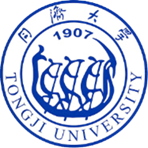|
The bottleneck of thermoelectrics is their low efficiency, focusing on the fundmental physics and chemistry of thermoelectrics, the team devotes the efforts on the design and development of high-efficiency thermoelectric materials and devices. Based on our previous knowledge, we will continue our work on the topics including: 1. Advanced synthesis technology; 2. Comprehensive characteriazation of electrical, thermal, optical, magnetic properties and microstructures; 3. Underlying physics and chemistry of energy materials; 4. Design and development of novel energy materials under the guidance of theory; 5. New semiconductor materials for other applications. 本研究小组主要针对当前热电材料转换效率较低这一技术瓶颈,从热电材料所涉及的基本物理及化学问题出发,设计和开发出高转换效率热电材料和器件。立足于前期工作的基础之上,今后具体的研究对象主要集中在半导体材料,研究内容主要包括:1.先进的材料制备方法;2.电、热、光、磁及微观结构的表征方法;3.能源材料性能所隐含的基本物理及化学问题;4.理论指导下的新型能源材料设计和开发;5.其它应用背景的半导体新材料的研究与开发。 Research topics (研究方向) Fundmental Physics of Thermoelectrics (热电材料基础物理) Microstructure (微结构) Band Convergence (能带汇聚) Effective Mass(有效质量) Carrier Scattering (载流子散射) Band Gap (禁带宽度) Functional Gradient Thermoelectrics (功能梯度热电材料)   If a material can be doped and the dopant does not change the scattering type by phonons, electronic or phonon structure significantly, but only the Fermi level then the maximum zT depends only on the quality factor (B) first defined by Chasmar and adopted by Goldsmid determines the maximum zT of a material. This leads to the strategy to obtain high zT materials by having a large number of band valleys (Nv), a low inertial effective mass (mI*), and a low scattering strength (Edef) and a low lattice thermal conductivity (kL).   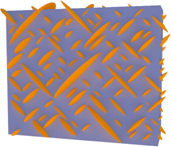 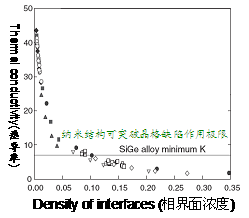 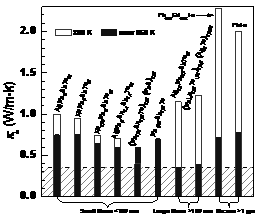 Utilizing the equilibrium phase diagram and precipitation kinetics, we developed a controllable technique for making thermoelectric nanocomposites. We directly observed a significant reduction in lattice thermal conductivity due to the well controlled nanostructures. It is also demonstrated that the critical parameter for phonon scattering is the interface spacing but not the size of the inclusions as normally emphasized. Most importantly, it is found that many nanostructured thermoelectrics have their lattice thermal conductivity approaching the theoretical minimum, which limits the further enhancement in zT into a narrow space by reducing the lattice thermal conductivity only. This guides us to increase thermoelectric performance through other strategies such as band structure engineering for electronic property enhancement. 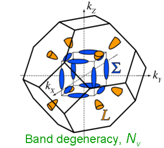 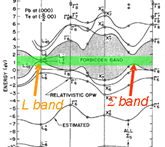 PbTe band structure 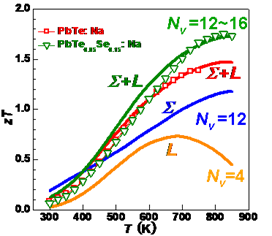 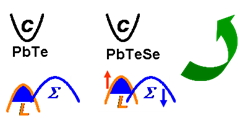 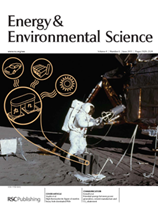 We proposed band convergence as a new concept for increasing zT. High band degeneracy (Nv) originates from both crystal symmetry and overlapped electronic orbitals. It may be impossible to increase symmetry-related Nv in a given material, one effective way is to converge different bands. Alloying PbTe with PbSe is a good example to converge the two different bands (L and S) to have an effective Nv of 12-16, being significantly higher than any known thermoelectrics that typically have Nv no more than 6. We can think converged bands concurrently transport carriers and thus increase the conductivity independently without affecting the Seebeck coefficient. High Seebeck coefficient by high density of states effective mass, is commonly considered as a route to thermoelectrics. This is only ture when high band degeneracy leads to high density of states mass. Large density of state mass due to flat bands leads to large transport mass, leading to a significant decrease of mobility. In fact, the net effect is a lower thermoelectric figure of merit, zT, when acoustic scattering dominates. We demonstrated the beneficial effect of light effective mass contributes to high zT in PbTe, where doping and temperature can tune the effective mass. This clear demonstration of the deformation potential theory shows the guiding principle for band engineering in thermoelectrics should be low effective mass along the transport direction . 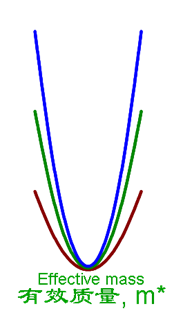 Surprisingly, both n- and p-type PbSe can achieve zT above 1, making PbSe a competitive and less expensive alternative to PbTe. High zT In p-type is due to the convergence of bands. In n-type PbSe, with much smaller band degeneracy, high zT achieved is due to a weak scattering strength (deformation potential—the degree of interaction between charge carriers and lattice vibrations), which leads to higher mobility of electrons compared to that of holes. We demonstrated the importance of scattering strength in selecting and engineering optimum band structures for thermoelectrics. 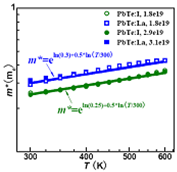 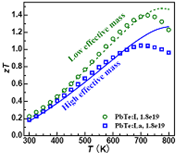 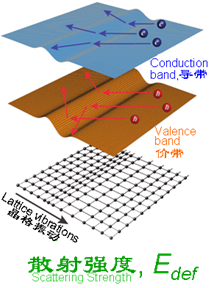 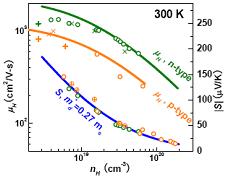  The thermoelectric performance of narrow band gap semiconductors such as Ag2Te and PbTe can be improved by increasing the band gap through alloying. The widened band gap helps prevent the onset of bipolar effect due to the existence of minority carriers. A further combination of intrinsically low lattice thermal conductivity in these narrow band gap semiconductors, enables a zT of unity or higher, emphasizing the necessary exploitation of narrow band gap semiconductors materials for potential thermoelectric applications.   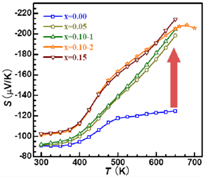 It can be estimated that the optimal carrier concentration (n*) was proportional to (m*T)^1.5 for thermoelectrics having single type carriers. This leads to n* strongly depends on T and m*, and therefore a great challenge to maximize zT in the entire temperature range. A straightforward strategy to address this issue is by functional grading of doping concentration, but it presents challenges such as dopant solubility and diffusion requirements. Within a single material, such a requirement can be achieved if the dopant solubility increases with temperature; alternatively, a similar net effect can be achieved without actually change the carrier concentration, if m* decreases with temperature and thus stabilizesn* vs. T. Both strategies are demonstrated in PbTe to be effective to enhance the overall thermoelectric efficiency by about 40%, providing a big advantage for practical applications. 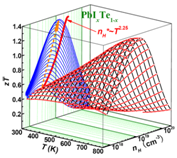 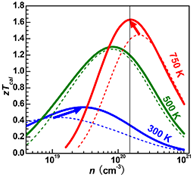 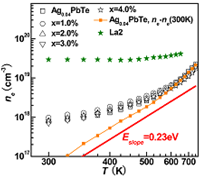 Optimal carrier concentration strongly depends on temperature |





热电应用

